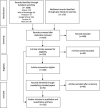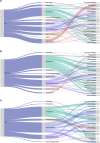Illegal wildlife trade and other organised crime: A scoping review
- PMID: 34851513
- PMCID: PMC9110579
- DOI: 10.1007/s13280-021-01675-y
Illegal wildlife trade and other organised crime: A scoping review
Abstract
The global illegal wildlife trade has been anecdotally linked to other serious crimes, such as fraud, corruption, and money laundering, as well as the cross-border trafficking of drugs, arms, counterfeit goods, and persons. As research on this topic is scarce and sporadic, we conducted a scoping literature review to gather information across multiple disciplines and evidence types on crime convergences in the illegal wildlife trade. We reviewed 150 papers published between 2000 and 2020. We found that the illegal trade in many of the most frequently trafficked species have reportedly converged with numerous other serious and organised crimes, most commonly drug trafficking. Convergences can occur in a variety of ways, although the diversification of organised crime groups, parallel trafficking of contraband, and use of enabling crimes (such as corruption and violence) were the most frequently described. Possible explanations for our results and future research directions are discussed.
Keywords: Conservation; Corruption; Crime convergence; Environmental crime; Organised crime; Wildlife trafficking.
© 2021. The Author(s) under exclusive licence to Royal Swedish Academy of Sciences.
Figures






Similar articles
-
Wildlife crime in Australia.Emerg Top Life Sci. 2021 Sep 24;5(3):487-494. doi: 10.1042/ETLS20200288. Emerg Top Life Sci. 2021. PMID: 33533406 Free PMC article. Review.
-
A data set of the crackdown on cross-border wildlife crimes in China, 2014-2020.Ecology. 2023 Jun;104(6):e4046. doi: 10.1002/ecy.4046. Epub 2023 Apr 13. Ecology. 2023. PMID: 36998172
-
Assessing the extent and nature of wildlife trade on the dark web.Conserv Biol. 2016 Aug;30(4):900-4. doi: 10.1111/cobi.12707. Epub 2016 Apr 28. Conserv Biol. 2016. PMID: 26918590
-
Quantitative methods of identifying the key nodes in the illegal wildlife trade network.Proc Natl Acad Sci U S A. 2015 Jun 30;112(26):7948-53. doi: 10.1073/pnas.1500862112. Epub 2015 Jun 15. Proc Natl Acad Sci U S A. 2015. PMID: 26080413 Free PMC article.
-
Wildlife for sale.Biologist (London). 2000 Feb;47(1):27-30. Biologist (London). 2000. PMID: 11190214 Review.
Cited by
-
Current wildlife crime (Indian scenario): major challenges and prevention approaches.Biodivers Conserv. 2023;32(5):1473-1491. doi: 10.1007/s10531-023-02577-z. Epub 2023 Mar 20. Biodivers Conserv. 2023. PMID: 37063172 Free PMC article. Review.
-
Human-Caused High Direct Mortality in Birds: Unsustainable Trends and Ameliorative Actions.Animals (Basel). 2024 Dec 31;15(1):73. doi: 10.3390/ani15010073. Animals (Basel). 2024. PMID: 39795016 Free PMC article.
-
Discrimination of mongoose hair from domestic cattle hair, human hair, and synthetic fiber using FTIR spectroscopy and chemometric analysis: a rapid, cost-effective, and field-deployable tool for wildlife forensics.RSC Adv. 2024 Nov 19;14(50):36937-36944. doi: 10.1039/d4ra06981a. eCollection 2024 Nov 19. RSC Adv. 2024. PMID: 39569126 Free PMC article.
-
Genetic Evidence Reveals Distinct Lineage of Chinese Pangolin in Nepal: Insights From Scat and Blood Samples for Conservation and Wildlife Forensics.Ecol Evol. 2025 Feb 16;15(2):e70982. doi: 10.1002/ece3.70982. eCollection 2025 Feb. Ecol Evol. 2025. PMID: 39958816 Free PMC article.
References
-
- Anagnostou M. Synthesizing knowledge on crime convergence and the illegal wildlife trade. Environmental Challenges. 2021;2:100222. doi: 10.1016/j.envc.2021.100222. - DOI
-
- Anagnostou M, Moreto WD, Gardner CJ, Doberstein B. Poverty, pandemics, and wildlife crime. Conservation and Society. 2021 doi: 10.4103/cs.cs_193_20. - DOI
-
- Anagnostou M, Mwedde G, Roe D, Smith RJ, Travers H, Baker J. Ranger perceptions of the role of local communities in providing actionable information on wildlife crime. Conservation Science and Practice. 2020;2:e202. doi: 10.1111/csp2.202. - DOI
-
- Baker SE, Cain R, Van Kesteren F, Zommers ZA, D'cruze N, Macdonald DW. Rough trade: Animal welfare in the global wildlife trade. BioScience. 2013;63:928–938. doi: 10.1525/bio.2013.63.12.6. - DOI
-
- Cantú Guzmán JC. The illegal parrot trade in Mexico: A comprehensive assessment. Washington: Defenders of Wildlife; 2007.
Publication types
MeSH terms
LinkOut - more resources
Full Text Sources
Research Materials

